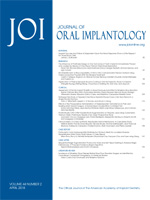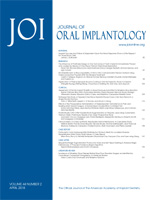[ad_1]

Journal of Oral Implantology Volume 46 Issue 4
Some of the risks they discussed in this case study included Bf duration, type, and administration method; and bone trauma during prosthetic installation.
LAWRENCE, Kan. (PRWEB)
October 12, 2020
Journal of Oral Implantology – Dental implants improve the quality of life of many people; however, side effects, such as osteonecrosis—bone tissue death—can occur in patients who take a group of drugs known as bisphosphonates (Bfs) as therapies for bone conditions. This, in turn, impacts the long-term survival rate of implants. Authors of a recent study in the Journal of Oral Implantology successfully treated a patient with low bone mass, a condition called osteopenia, and discussed treatment decisions they made after a thorough review of the literature.
Researchers and clinicians from Maringá, Brazil, were presented with a 53-year-old female patient who wanted dental implants to replace missing teeth. A medical history assessment revealed that the patient had osteopenia and took Bfs. To treat their patient most successfully, the authors reviewed the literature for rates and risks of osteonecrosis after dental implantation and possible ways to mitigate those risks. Some of the risks they discussed in this case study included Bf duration, type, and administration method; and bone trauma during prosthetic installation.
To prevent osteonecrosis in this patient, the authors chose three specific strategies. First, based on American Dental Association guidelines and previous literature, they suspended the patient’s Bf administration for 3 months before and after surgery. Second, the authors provided their patient with a 7-day treatment of clindamycin to prevent bacterial colonization, as some previous studies suggest that infection can enhance the risk of osteonecrosis. Third, they installed the Straumann bone level tapered implant to improve healing time of the bone around the implants. Overall, the patient received a total of three implants and no osteonecrosis has been reported thus far according to examinations and radiographic image analyses.
Additionally, the authors highlight that C-terminal telopeptide (CTX) values, a biomarker for bone remodeling, are often correlated with osteonecrosis risk. Although the patient in this case study had a low risk according to these values, the authors cite several articles in which the two cannot be correlated. Thus, they advise against using CTX as a conclusive measure to assess risk.
Through this detailed case study, it is clear that there are many decisions to be made when considering dental implant treatments for patients with bone disease and those who take Bfs. Therefore, clinicians should conduct a detailed review of medical records before conducting oral rehabilitation in patients who have underlying conditions and take medications.
Full text of the article “Oral Rehabilitation with Dental Implants and the Importance of a Preventive Evaluation for Osteonecrosis of the Jaws Associated with Medications,” Journal of Oral Implantology, is available at https://doi.org/10.1563/aaid-joi-D-19-00275.
###
About the Journal of Oral Implantology
The Journal of Oral Implantology is the official publication of the American Academy of Implant Dentistry and of the American Academy of Implant Prosthodontics. It is dedicated to providing valuable information to general dentists, oral surgeons, prosthodontists, periodontists, scientists, clinicians, laboratory owners and technicians, manufacturers, and educators. The JOI distinguishes itself as the first and oldest journal in the world devoted exclusively to implant dentistry. For more information about the journal or the society, please visit http://www.joionline.org
Share article on social media or email:
[ad_2]

